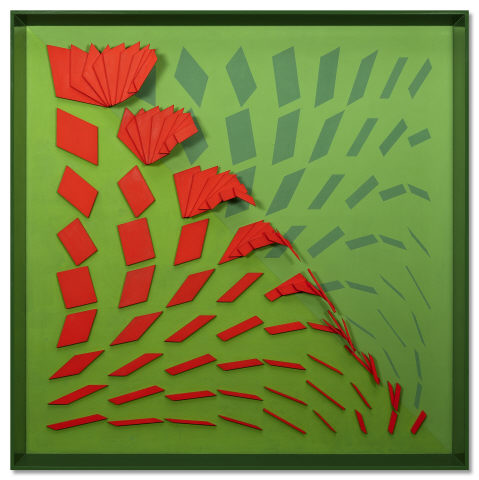
- 1967
- Wood
- Painted wood
- Inv. E1509
Artur Rosa
Evolução de um losango numa malha logarítmica
Mixing op art influences absorbed during the 1960s with clear geometric leanings and a mastery of scientific-technical methods, the rigorous practice that characterises Artur Rosa’s drawing is reflected in his paintings and sculptures, which, in the spatial and volumetric harmony of the composition, reveal evidence of his architectural training. In his works, the line traverses and shapes space, transforming it dynamically. The balance produced by the asymmetry makes this work an explicit example of contemporary taste, in which Artur Rosa explores the way in which geometric shapes move spatially, creating compositional grids imbued with intense dynamism and achieving balance through the contrast between full and empty spaces, colour and its effacement. For this reason, his shapes evoke the pure game, the infinite repetition of the number, the line, and the angle that creates folds in the light, doubling it, eliminating it, examining it, revealing its multiple facets.
The piece Evolução de um losango numa malha logarítmica (Evolution of a lozenge in a logarithmic grid) is an example of this. Created in painted wood, on which a group of lozenges progresses in a double linear, rotatory (and even folding) motion, in a sculptural exercise which evokes the precision of origami and demonstrates its countless mathematical, abstract, and at the same time, poetic possibilities in the subtle curved lines created by the dance of the figures. The square in which they are painted, dominated by the grid of lozenges, highlights the geometric character of the composition, in which the straight lines dominate and render more necessary and more obvious the need for a suggested arrangement of curves. The economy of the palette (reduced to one red, two shades of green, and some shadows cast by the relief of the overlaid figures) underlines the mathematical objectivity of the whole and manages, through the contrast created, to reciprocally light up the colours, lending the composition an intense luminosity.
In effect, as in the rest of the artist’s work, the pure geometric shapes that move through space are (un)folded in an exercise that demonstrates their infinite mathematical and abstract possibilities. They evoke nothing beyond themselves or beyond the infinite repetition of the number, the line, and the angle that folds the light, flattens it, and examines it. In this way, in a language mixed with infinite possibilities, a work is constructed that declares itself to be somewhere between a scientific, a sculptural and a pictorial object. This means that, even when he is engaged in painting, his work also responds to the demands of a piece of sculpture, adopting the same assumptions, both in the outline or design of the geometric elements that progress through it as well as in the way in which colour mimics volume, as if the tonal modellings that are used had been transformed into material density.
In this case also, the physical distancing evident between the geometric figures and the support accentuates the play between interior and exterior that persists in his sculpture and introduces the shadow as a compositional element. The habitual, optical play evident in his work therefore continues to assert itself, clearly and playfully, in this piece.
Emília Ferreira
May 2010
| Type | Value | Unit | Section |
| Height | 115 | cm | |
| Width | 115 | cm | |
| Depth | 12,9 | cm |
| Type | A definir |